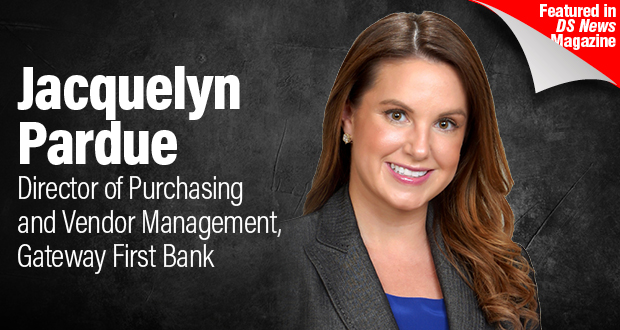 Jacquelyn S. Pardue manages and oversees vendor management, leases, and compliance for Gateway First Bank. Pardue has more than a decade’s experience in the mortgage and lending industry, including serving as the COO at AgileOne Solutions. She has held various leadership roles at Pacific Union Financial, Rushmore Loan Management Services, and Wingspan Portfolio Advisors. Pardue holds a bachelor’s degree from Texas Tech University and is currently pursuing an MBA from Syracuse University. She recently spoke to DS News about the state of the industry and the challenges facing servicers.
Jacquelyn S. Pardue manages and oversees vendor management, leases, and compliance for Gateway First Bank. Pardue has more than a decade’s experience in the mortgage and lending industry, including serving as the COO at AgileOne Solutions. She has held various leadership roles at Pacific Union Financial, Rushmore Loan Management Services, and Wingspan Portfolio Advisors. Pardue holds a bachelor’s degree from Texas Tech University and is currently pursuing an MBA from Syracuse University. She recently spoke to DS News about the state of the industry and the challenges facing servicers.
What are some of the challenges that servicers have faced so far in 2019?
The biggest challenge servicers are currently facing that there is a desire to innovate and bring in new technology, but there are also difficulties that come along with that. How do we implement new tech into our legacy systems, and how can we ensure that everything is going to work and do what it's supposed to do?
Is it harder to make technological innovations happen on the default side?
There is less cash flow on the servicing side, so the margins are much tighter and more restrictive. You also have levels of more historical systems in place, as well as a lot of homegrown aspects. How do you bring together all these parts and pieces that people have built on top of each other over the course of so many years? How do you implement something new that's going to work successfully with all those elements?
From a servicer's perspective, what lessons have you taken away from previous natural disasters?
In my previous life, I functioned through many of the hurricanes and dealt with many related challenges, even within Puerto Rico. One of the biggest things that servicers can do to innovate is to be proactive. How can we get in touch with our borrowers when we know that there's a possibility of a disaster, and to let them know how to get in contact with us? Servicers also need to find ways to contact borrowers that isn't going through the mail or email, because often these people might not be in their homes in the aftermath of one of those events—they might have been forced to leave their house. They may not have access to their mail, or there may be difficulties in getting it to them, depending upon the situation. You must have the ability to ensure that the contact information is being updated for borrowers in these situations.
You also need to ensure that you have the right vendor partners in place. If you know you're going to have an increased load of calls, you must have additional capacity to input those calls within an outsourced model or a call center. Or you need enough flexibility internally that you can implement weather technology that can help you pinpoint more targeted campaigns, depending upon who was affected, and how.
The biggest lesson is that everyone needs to make small adjustments based upon their lessons learned in the past. That’s one of the great things about Five Star’s Legal League or Disaster Summits, where everyone is sharing their knowledge and experiences. If it affects one servicer, at the end of the day it will likely wind up affecting other servicers. Those communal conversations can help us all get on the same page.
What are some of the challenges of interacting with third-party vendors?
The biggest challenge with third-party vendors is the interpretation of communication. Oftentimes, we're not communicating face-to-face anymore, we're not communicating in person. Everything is being done through email and other systems, and things can get lost in translation.
Also, many of the people in our industry have a tendency to move around throughout their careers. When people move, there’s a risk that internal knowledge and lessons have not been communicated throughout the organization.
There is often also a potential for a disconnect between what a contract says and what our expectations are. Sometimes, those things don't coincide. That typically comes down to gaps in communication, even with all the technology aspects that are designed to improve that. We're all based in different places, but how do we ensure that all those items are clear, and everybody remains on the same page through management changes and internal changes?
One lesson we’ve taken away when it comes to interacting with our attorney partners, for example, is ensuring that they have a clear playbook of what our expectations are, and that it's outlined not from a management or a legal perspective, but from an operational and tactical perspective. We’re working hard to be clear with our vendors and our partners about what we expect from them and how we want it to flow.
What other trends or changes do you predict will define the back half of 2019?
It’s always going to come down to technology and innovation. Everybody is going to say that. However, there’s also a lot happening on the front end of the industry that will inevitably affect the back end. Players like Amazon and Zillow are entering our industry, so what impact will that have on everything? We’ll have to wait and see.
You mentioned appreciating the communication facilitated by events such as the Legal League Summits. Could you speak more about why you think these events are important?
It's a wonderful opportunity for us as servicers to have a level of facetime with our vendors and attorneys. We’re emailing and interacting with these people constantly, but many times we’ve never really had the chance to introduce ourselves in person or shake each other's hands. Being able to put a face to a name, being able to have those in-person conversations, can be extremely valuable.
It’s also a chance for all of us to share insights about what’s working for us, as well as what hasn't worked. Those conversations are critical, and it provides an opportunity for level-setting and being able to take new insights and lessons back to our organizations.
